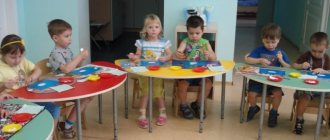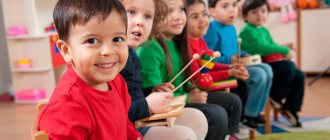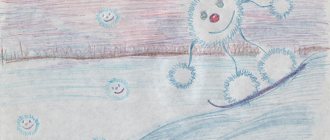What is creativity
By definition, this is the process of human creation of new unique material and spiritual values (products, things). Every person is unique. This means that everything he creates is unique and inimitable.
Let me give two examples for clarity.
A) We, being in the same room, see in front of us what seems to be the same view from the window, but if we are asked to draw what we see, each of us will draw his own picture, highlighting and focusing attention on different fragments of what he saw and painting the picture in your own colors.
B) We know what, for example, a butterfly looks like, but each of us, making it in the form of a craft, even having the same pattern, will create our own unique butterfly, choosing different materials for the craft and a different color combination.
Do you know how the creative process itself occurs ? Now I will tell you about everything in order.
In the process of studying and understanding the world around you, you have an idea to create or do something like that. Perhaps this is not your idea, but an idea suggested to you by adults, but you liked it and you want to implement it. So, first the idea for creativity arose. What's next?
Now you need to determine what you need in order to bring this idea to life. For example, to draw a regular picture you need an album or drawing paper, paints, felt-tip pens or pencils. That is, we prepare the means to implement a creative idea. And then it’s up to your fantasy, imagination and skill (skill).
And finally, after bringing your creative idea to life, you need to evaluate the result of your creativity. First, you need to understand whether, first of all, you like this result and whether you have a desire to continue to create something in this direction. Then you can find out the opinions of others. Keep in mind that the opinions of others may not coincide with your feelings and impressions of what you have created (history knows many cases when geniuses were not recognized).
But the main thing in creativity is the desire to create, the desire to create something new, unusual and through creativity to give love and kindness to the people around you.
What materials are used for the work?
A variety of materials are used for children's creativity. These can be natural, waste materials, fabrics, ropes, old things, paper and much more. The purpose of decorative art is to use available materials to create something that could be used in everyday life or serve as decoration.
Materials you will need:
- paper: colored, corrugated, writing, papyrus, velvet, newspaper, double-sided, self-adhesive, tracing paper, paper napkins, foil;
- cardboard: white, colored;
- fabric: cotton, linen, synthetic, colored, plain, with patterns;
- cotton wool: cotton wool, cotton swabs and disks;
- natural material: seeds of plants, fruits and vegetables, cones, acorns, leaves, tree branches, feathers, stones, sand;
- different types of cereals, curly pasta;
- waste material: plastic cans, boxes, lids;
- wooden sticks, toothpicks;
- decorative elements: beads, rhinestones, seed beads, sequins, braid;
- plasticine, salt dough, clay;
- threads and ropes of different types and different colors;
- glue stick for paper, starch paste, PVA glue;
- paints, brushes, felt-tip pens, pencils, markers;
- wet wipes for hands, oilcloth, sippy cup for water.
Children's creativity and its main types
Children's creativity, in principle, is no different from the creativity of an “adult”. Except that it is created by children, and as you know, children have more developed imagination and imagination compared to adults.
Children perceive the world around them somewhat differently, which makes their creativity especially attractive. Children have no fear of creating, they are open to the world, with childlike spontaneity, delight and purity of dreams, they absorb all its manifestations, rejoicing at every new, even tiny, discovery for themselves.
Children's creativity can be divided into three main types: artistic, technical and musical. Although, as you understand, there are children who make discoveries (this is scientific creativity) and teach their peers new knowledge (this is pedagogical creativity), thus engaging in “adult” types of creativity.
Children's artistic creativity
these are: - drawing using a variety of drawing tools, - sculpting crafts from clay and plasticine, - creating artistic compositions, crafts and applications from various natural and artificial materials, - embroidery, - creating literary and musical works (poems, fairy tales, stories, songs, music).
Technical children's creativity
involves the design and modeling of various devices, models, mechanisms (for example, ships, various aircraft, toys, origami, kaleidoscopes...)
Musical children's creativity
represented by playing various musical instruments, singing, dancing and rhythm.
In each of these types of children's creativity, you can choose an activity to your liking, fully demonstrating your creative abilities.
Development and education of preschool children through artistic creativity
Olga Suldina
Development and education of preschool children through artistic creativity
impossible to educate a creative personality , that is, to form the context, conditions and attitude towards creativity , on the one hand, and the need and motivation for creativity , on the other, without special efforts of society, without appropriate policies aimed at this cultural goal. creative being by nature , man has a penchant for artistic activity . From an early age, children try their hand at singing, drawing, and the art of speech.
Developing and improving these inclinations and abilities is one of the tasks of aesthetic and artistic education and development , which are one of the most important means of qualitative improvement of human nature.
Artistic education for preschoolers includes classes in graphics, modeling, painting, origami and many other types of art. Any artistic activity of a child and creative form his imaginative thinking, contribute to the development of imagination , and also help him express his feelings and emotions. A child who is still poorly able to express his thoughts in words will always be able to express them in creativity , in art. Creativity opens up wide scope for him to choose the means of transmitting his feelings and emotions to the outside world and helps him share his experiences. Artistic activities calm the child and his nervous system, contribute to the development of patience and perseverance.
The purpose of teaching artistic skills is not only to give children knowledge and skills in singing, drawing, reading poetry, but also to arouse their interest and desire for independent creative activity .
The goal of artistic education of preschool children is to create conditions for the holistic emotional and aesthetic development of preschool children , introducing them to art of various genres and artistic creativity . Preschoolers learn modeling , drawing, various crafts and much more. Fine and other types of art develop imagination , perseverance, memory and fine motor skills. In addition, the activities provide children with a lot of fun.
Artistic education of preschool children is one of the most important areas in child development , which requires special attention. This is an integral part of the aesthetic education of children , and it actually begins from the moment of birth. Artistic education effectively influences the overall development of a child's personality and promotes his intellectual and moral development .
Introducing a preschool to art is formed by such means as:
• introducing preschoolers to creativity and various works of art, getting them interested in this activity, finding their creative potential ;
• classes with preschoolers , depending on age and personal characteristics, with various types of artistic and creative activities , ensuring the child’s free choice of direction in creativity .
Fiction and artistic creativity are aimed at developing in children:
• independence of thinking;
• curiosity;
• cognitive interest;
• artistic taste;
• creative skills;
• feelings of beauty.
It is a fair statement that if people stop reading, they will stop thinking. Nowadays, it is necessary to recognize the reading process as determining the education and moral development of a person.
The formation of a child as a reader begins at an early age, and experts call preschool “library”
- for children's interest in books.
But in order for a child to grow up to be able to navigate well in the book world, rhetorically literate, thoughtful, and able to empathize with the characters of books, and then with those around him, additional special “library”
classes are needed.
Acquaintance with the vast literary heritage will be based on the foundation that we lay in preschool childhood .
The main task of the teacher is to instill in children a love of the literary word and respect for the book.
Fiction opens and explains to children the life of society and nature, the world of human feelings and relationships. It not only entertains and pleases children, but also lays the foundations of morality, develops the child’s thinking and imagination, enriches his emotions, and provides examples of literary language.
“One of the most important problems of pedagogy is to give a child life in the world of books. I see educational task of exceptional importance in making reading the strongest, irresistible spiritual passion of every child, so that in a book a person will find an attractive and luxurious communication with thought, beauty, the greatness of the Russian spirit, and an inexhaustible source of knowledge for the rest of his life. This needs to be taught, taught and taught - an introduction to the joys of life in the world of books.” These words belong to the Russian teacher V. A. Sukhomlinsky.
Currently, the principle of variability has been proclaimed in Russian education, which gives teaching staff the opportunity to choose and model the pedagogical process from any perspective. This direction is progressive in education, as it opens up opportunities for the development of various options for the content of the educational process, the use of modern didactics in increasing the efficiency of educational structures, scientific development and practical justification of new ideas and technologies.
To get acquainted with fiction , various didactic materials, illustrations for literary works , finger puppets, and table theater are used, which helps to increase children’s interest in classes and activate speech activity.
In the system of innovative methods and techniques in pedagogy, special techniques, such as fairy tale therapy, puppet therapy, paintography, and the use of substitute objects, occupy more and more space.
At older preschool age, children are able to understand the idea, content and expressive means of language, and realize the beautiful meaning of words and phrases.
Gradually, children develop a selective attitude towards literary works and an artistic taste .
Visual activity is one of the first and most accessible means of self-expression of a child, in which the originality of many aspects of the child’s psyche is manifested. Drawings and children's crafts are a powerful means of cognition and reflection of reality; they reveal the peculiarities of thinking, imagination, and the emotional-volitional sphere.
One of children's favorite activities is drawing. Children's drawings vividly and comprehensively reflect the world around them. Children love to draw positive characters who arouse their sympathy. By this they reveal their positive emotions and correctly evaluate the actions of the heroes.
Modeling is one of the types of visual activities for preschool . Modeling is of great importance for the training and education of preschool children . It a beneficial effect on the all-round development of the child . It promotes the development of visual perception , memory, imaginative thinking, and the instilling of manual skills and abilities necessary for a child.
Modeling, like other types of visual activity, forms aesthetic tastes, develops a sense of beauty , the ability to understand beauty in all its diversity. Modeling by its nature requires, on the one hand, developed sensations and perceptions , and on the other, it itself improves these perceptions and sensations . It is believed that vision is leading in the knowledge of objects in the real world, but in the first stages of development in children, the support for vision is the touch of an object.
Thus, artistic creativity contribute to the optimal and intensive development of all mental processes and functions, teach the child to think and analyze, measure and compare, compose and imagine.
The pedagogical meaning of this is that education cannot be limited to just one genre of art. Only their combination will ensure the full aesthetic development of the child .
Creative abilities of preschool children
Creative abilities, like intellectual ones, belong to the group of cognitive abilities. Only the main load falls on various cognitive processes. In intellectual cognition, thinking plays a leading role, and in creative cognition, imagination plays a leading role. Therefore, the creative abilities of preschoolers begin to develop later - in the second half of preschool childhood.
A child can try on pyramid rings to fit them to size as early as two years of age. This indicates his intellectual development. But a preschooler will be able to see a new image in the same pyramid, calling it “girl”, “slide”, etc., when he receives numerous ideas about the world, comprehends analogies and activates his imagination.
The creative abilities of preschool children are an original approach to understanding the environment, a tendency to find non-standard ways and means of solving problems, and a desire to obtain original results.
Children can realize their creative potential in any type of activity. By drawing or constructing a structure, performing actions with toys, or being carried away by role-playing games, preschoolers are guided by their plan. Since the plan is formed on the basis of how the child perceives the surrounding reality, it can reflect a typical picture, but it can also be very unusual.
Directions for the development of children's creative abilities
Creativity rarely develops on its own. Their development needs stimulation. For this reason, it is important to know in what directions the creative abilities of preschoolers can be developed. There are two effective lines:
- Complicating actions in using means to implement plans
- Expanding the set of tools to solve a specific problem
As an example, consider how children use a bucket. In addition to its direct purpose, it can serve as a form for Easter cakes, the upper part of a constructed tower, a headdress, a chair, a support for a bridge, etc. But children come to this variability with the development of creativity.
The same goes for finding new means to realize your ideas. You cannot draw an outline - a preschooler will lay it out with sticks; no sticks - will line up cubes around the perimeter; there are no cubes - he will stretch out a jump rope or a strap... If there are no more or less suitable means, the older preschooler will act in imaginary circumstances.
Every time the search for suitable means and possibilities for their use is a kind of brainstorming for the creative thinking of a preschooler. Experience confirms that the most original ideas come AFTER trying more familiar options. It is important for adults to remember this fact and encourage the child’s activity in generating new ideas.
WHAT IS IT FOR?
So what does this creative potential give to a child?
- The ability to see what is hidden from others.
- The ability to synthesize many original ideas in a short time.
- Associate concepts that are not related at first glance.
- Apply to solve one problem the skills acquired in solving a completely different one.
- Create certain conditions under which an object exhibits hidden properties or capabilities.
- Find an alternative solution to the problem at hand instead of looking for an answer by going through ready-made options.
All this opens up broad horizons for self-realization. The less creativity is developed in a person, the more prone he is to constant dissatisfaction with others and himself, to self-criticism. Such a person builds subconscious barriers to achieving a goal and is afraid of bold decisions and big-picture thinking.
We should not forget that the entire culture of any people and humanity as a whole would be impossible without creativity. Literature, sculpture, architecture, painting, folklore - all this is the result of the creative activity of many people.
Even in science you cannot do without creativity. After all, first you need to imagine a task or object, its properties, benefits, etc. And then imagine how this can be achieved. And you don’t always need to think within the framework of standards.


